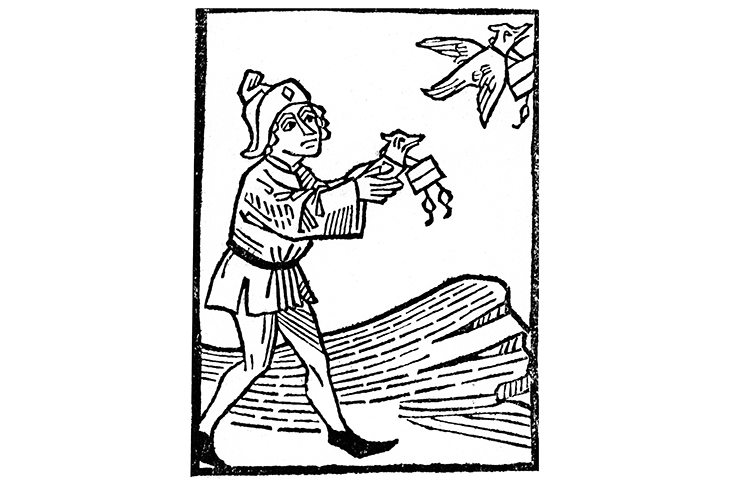Growing up as a rootless army brat in bases home and abroad, I would listen in appalled delight to my parents’ record of Tom Lehrer singing ‘Poisoning pigeons in the park’: ‘When they see us coming the birdies all try and hide/ but they still go for peanuts, when coated in cyanide.’ Now, I have lived in the same house for 20 years, determined to stay put, and every year a brace of feral pigeons join me by nesting under the eaves of my porch.
In Homing, Jon Day takes on the humble racing pigeon to ask just what home is, how we establish it, miss it and depart and return to it. He elevates this heroic bird to its rightful place in natural history and our history too, and celebrates its shared instinct with us for home.
Set principally in a London suburb in 2013, amid the housing crisis and Theresa May’s cold-shouldering of immigrants, the book is a moving biography of Day’s past and immediate relatives as he settles down from the itinerant freedom of bike couriering to start his own family and academic career.
His homing impulse begins with his partner: ‘I knew that wherever Natalya was, I wanted to make my home.’ But as an imminent father, he suffers an all too familiar moment of crisis and domestic doubt in B&Q. He decides to reawaken a childhood love of nursing birds and explore the world of pigeon racing — known as ‘the fancy’ among aficionados — to help re-seat his domestic psyche.
He has many fascinating accounts of how we’ve exploited these miraculous birds’ homing instincts in war and peace. Pigeons have bridged our communications from Roman times through to the 20th century. In the first world war, Major General Fowler said of them:‘When the battle rages and everything gives way, it is to the pigeon that we go for succour.’
Birds were also dropped into Occupied Europe in 1941, with labels for the Resistance to write down enemy positions and troop movements. Allied radio operators were supplied with pigeons if their packs failed on the landings in Normandy: in the event, they weren’t used, although some birds flew back to their lofts, feathers bloodied from the conflict. Afterwards, many British pigeons were awarded the Dickin medal for animal bravery.
By the 1960s, pigeon racing had become the most popular sport, by participation, in the UK. Day revels in the rich language and rituals of the fanciers (who included Charles Darwin and the Queen): ‘striking the clocks’ to synchronise the birds’ return times; ‘kit’ for a well-trained flock in flight; and ‘trapping’ for the birds’ return to their lofts to rest and feed. The breeds’ names — tipplers, tumblers, pouters, homers, trumpeters, nuns, turbits and blues — are also a delight.
Day writes of the fanciers’ devotion as ‘an attention that might best be described as love’, although he baulks at the culling the breeders carry out at the end of every season to keep their bloodlines ‘pure’. He values this respectful proximity to an animal who lives with us but has not been domesticated, like cats and dogs, into aping our needs. Pigeon-racing is more like bee-keeping; the birds are not simply creatures of their owners’ lives.
He is also sharp in addressing our antipathy to them, noting that
pigeons don’t fit into the stable categories of ‘wild’ and ‘tame’. They fly between two worlds — the natural and the man-made — thriving in both, but welcome in neither. They are highly adaptable pests, like us. We hate them because they remind us too much of ourselves.
Day swoops and soars over many fields of art and science to unravel our instinct for home. He writes about how our notion of home has changed: 400 years ago, domestic life was less solitary and nuclear, more communal and shared with animals. ‘In the Middle Ages, people didn’t so much live in their houses as camp in them.’ Now our lives seem more introverted. The older fanciers complain that the young of today are too locked into their gaming consoles to take on the sport.
On training runs with his birds across north-east London, Day takes pleasure in linking launch-points with local history. One of the ‘toss’ sites, Leyton Marshes, witnessed the first British powered flight in 1909, just six years after the Wright brothers. He offers up many such sympathetic historical and psychological digressions. Landscape and wildlife are treated in the same bright, spare prose. His understated lyrical style expresses beauty without sentimentality. On a rail trip to Blackpool to buy some birds, he looks out of the window:
From the train, England rumbled past: the blackened earth, the ice-topped ditches glinting in the sunshine. The trees were leafless and skeletal. Mist gathered in the dips of the fields and drifted over the surface of rivers.
His description of the pigeons settling in at home is a cosy delight:
In the evening they flew up to the drying rack, puffed up their feathers so that they looked like old men snuggling into oversized raincoats, and fell asleep on one leg.
Time and again he returns to the reciprocal notion that as we build and shape our home, it does the same for us, just as Darwin wondered whether the fanciers controlled their pigeons or were ruled by them. Day suggests, in turn, that pigeons have provided him with a sense of home after years of wandering: ‘I thought of pigeons as our own desire to nest.’ Or, to use one of the breed’s names — home is where the Hartog is.
Homing: On Pigeons, Dwellings and Why We Return
Author: Jon Day
Publisher: John Murray
Page count: 256
Price: £16.99






Comments